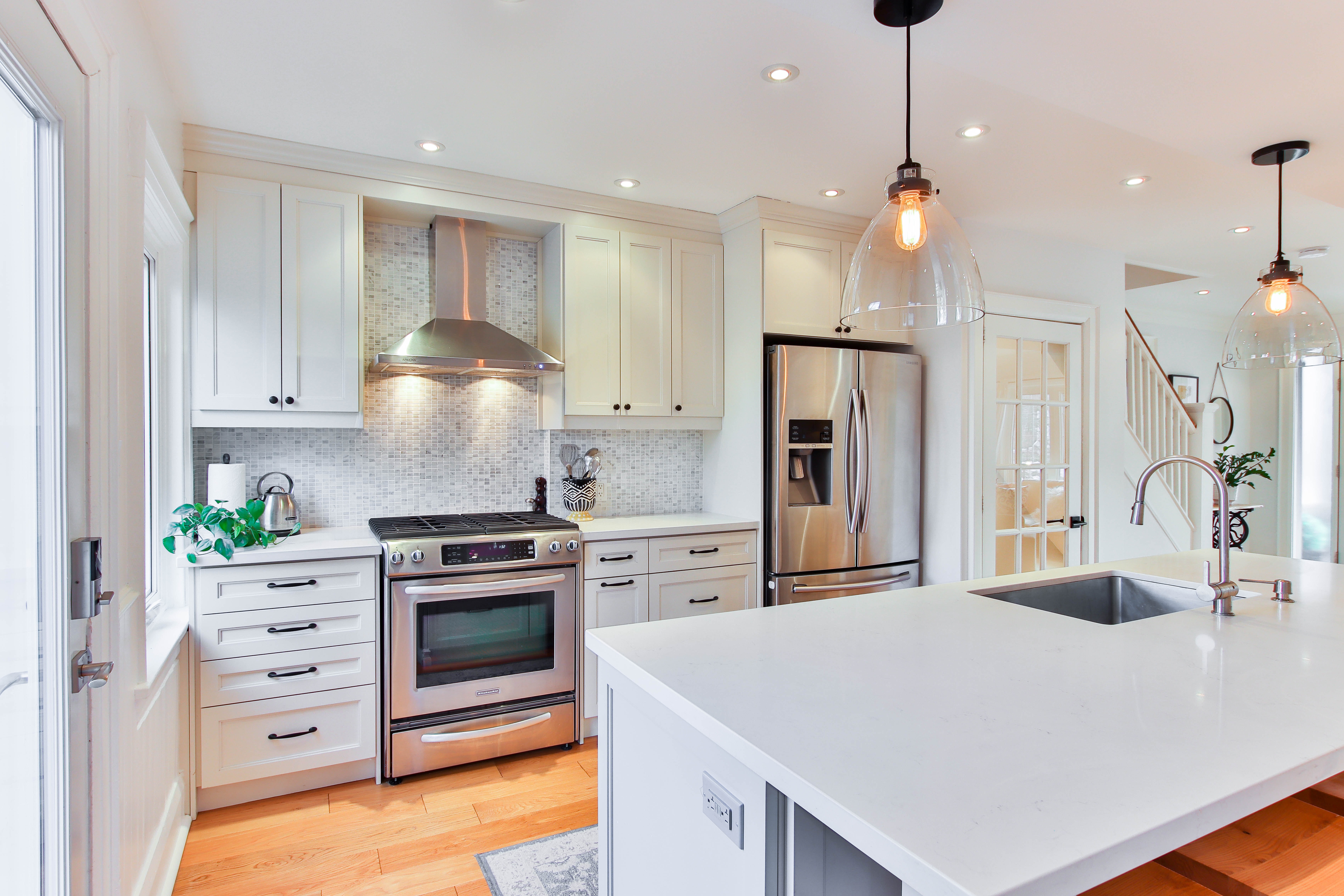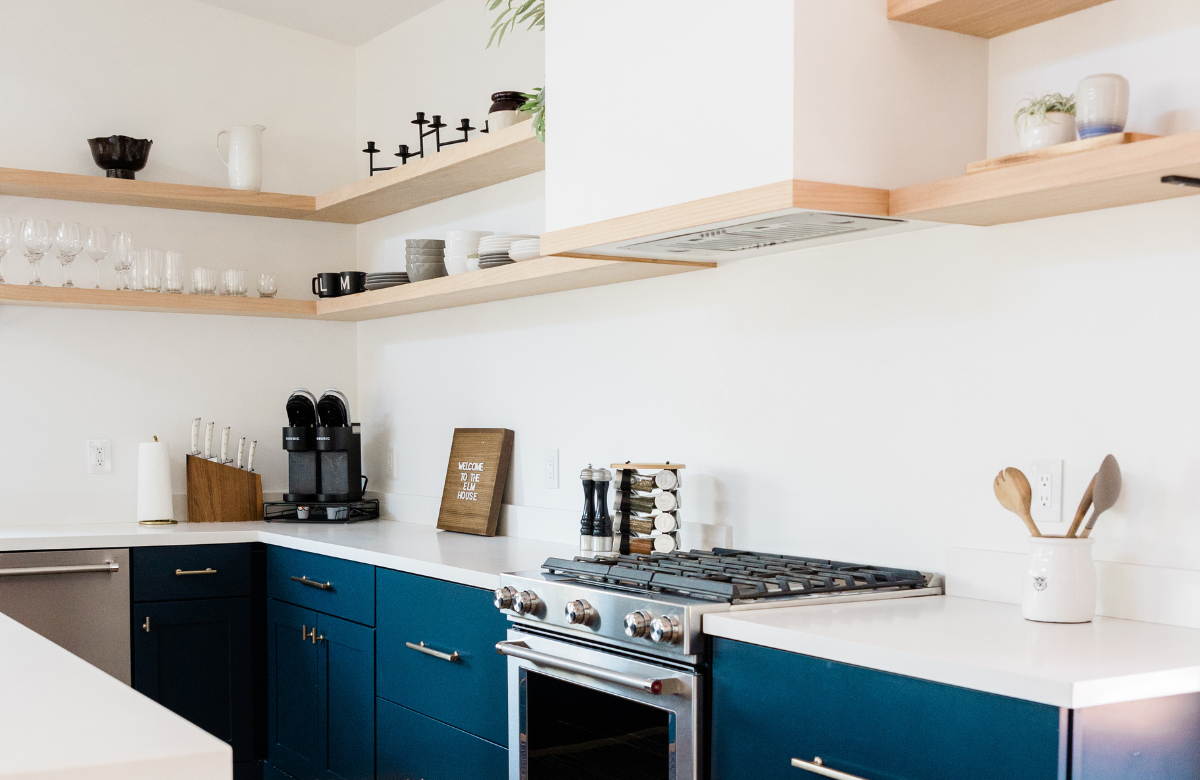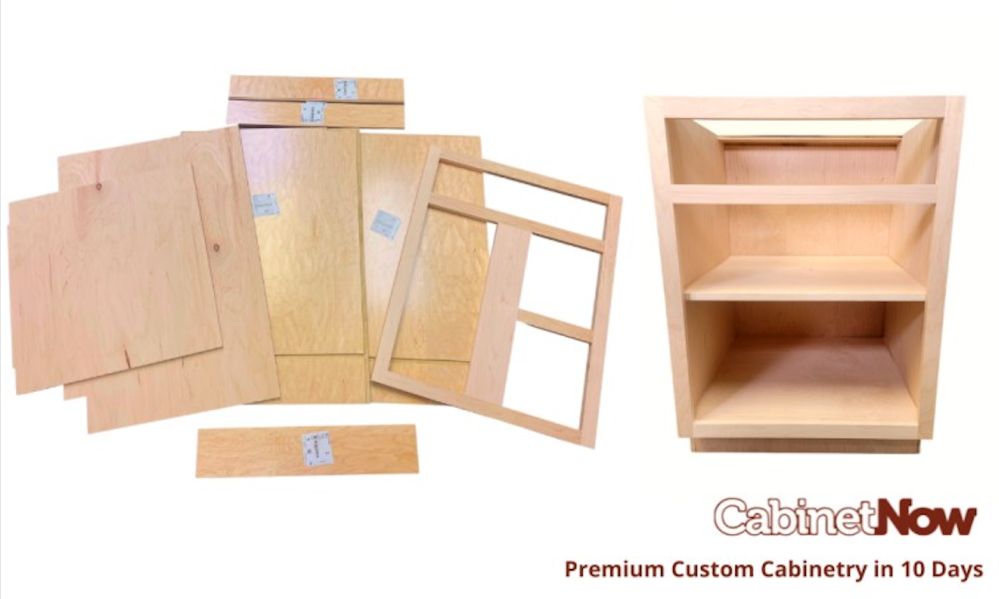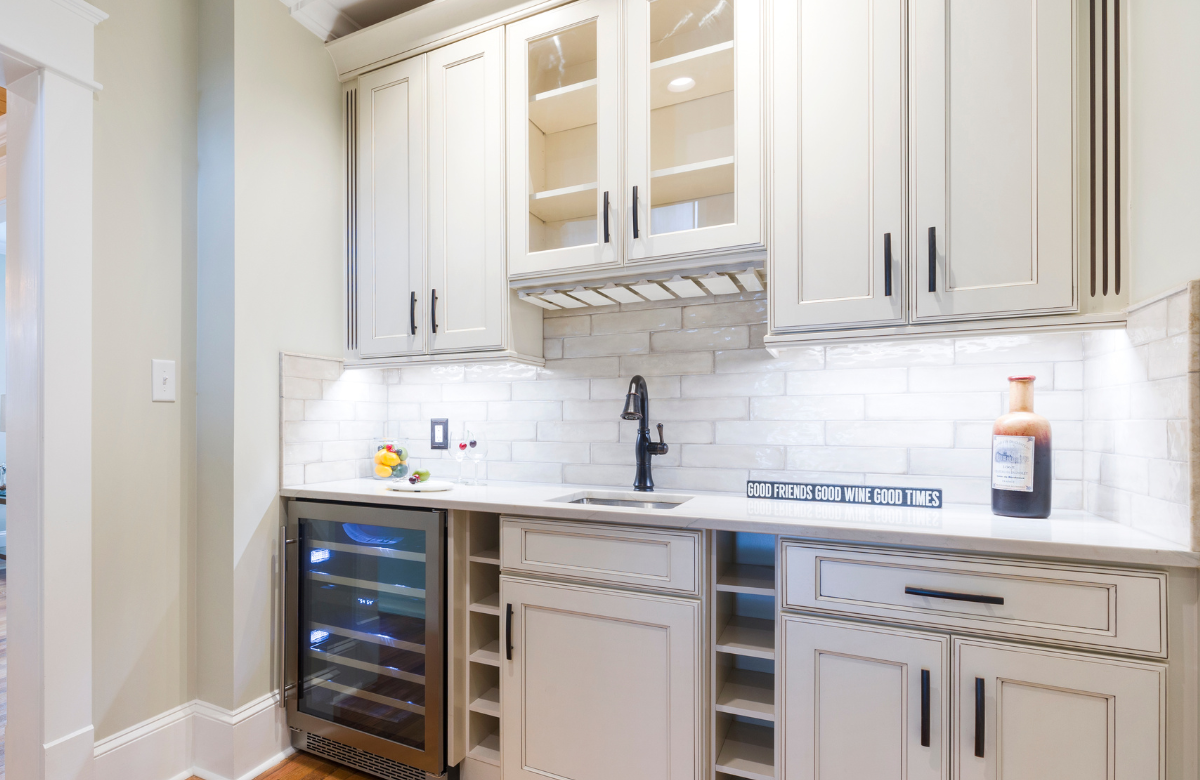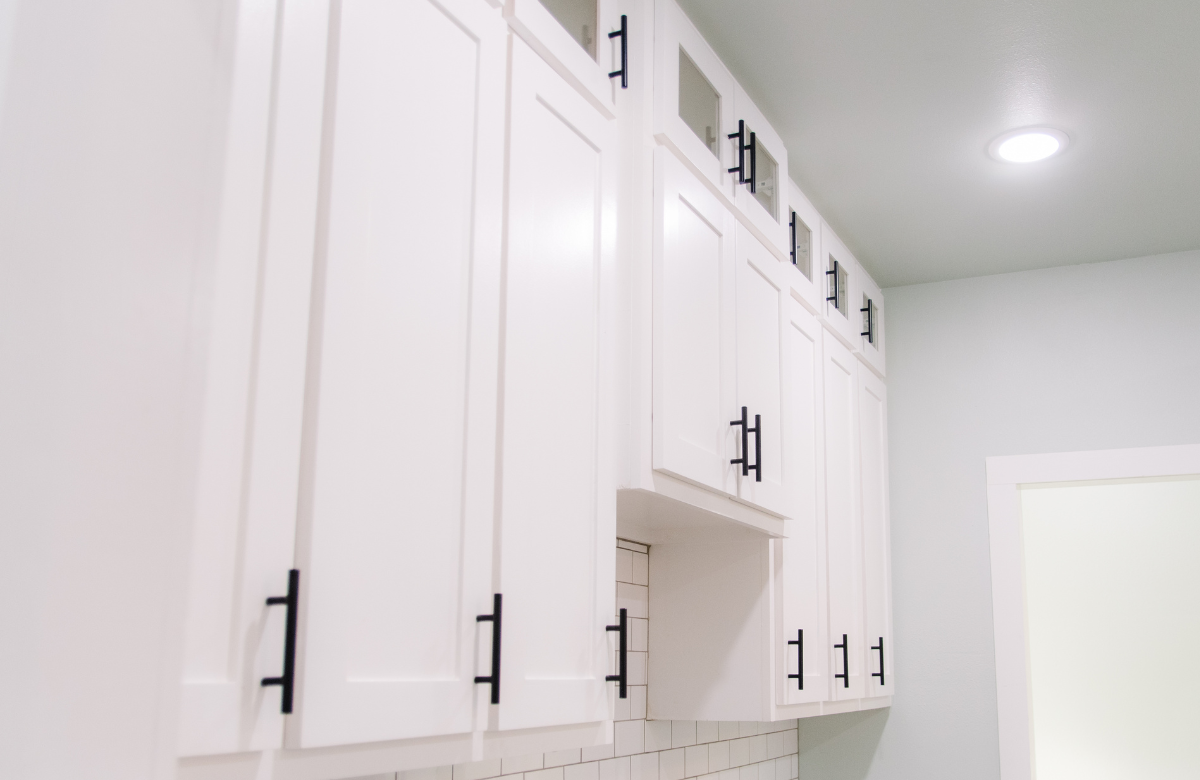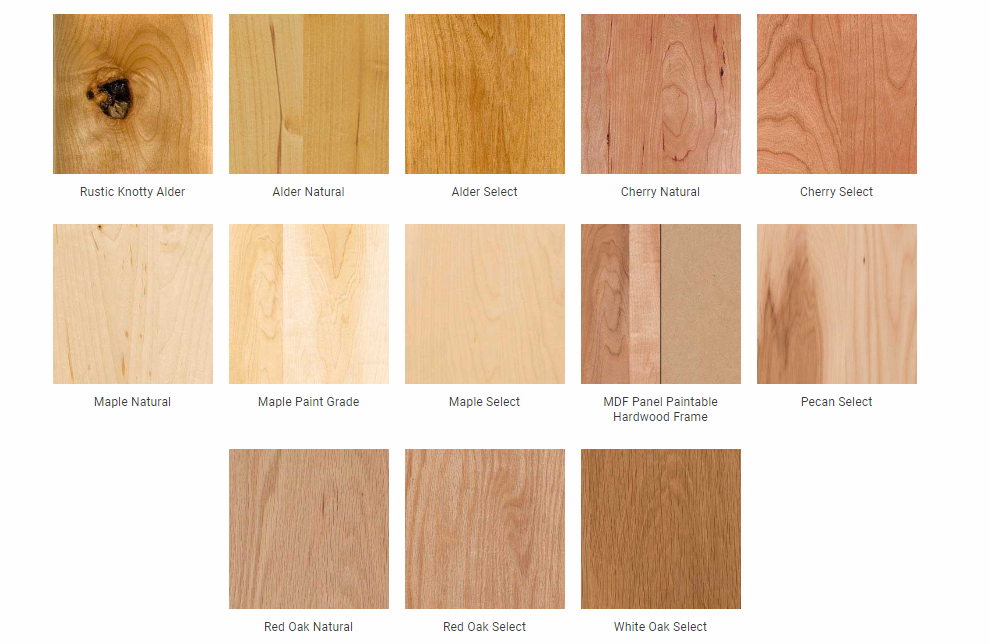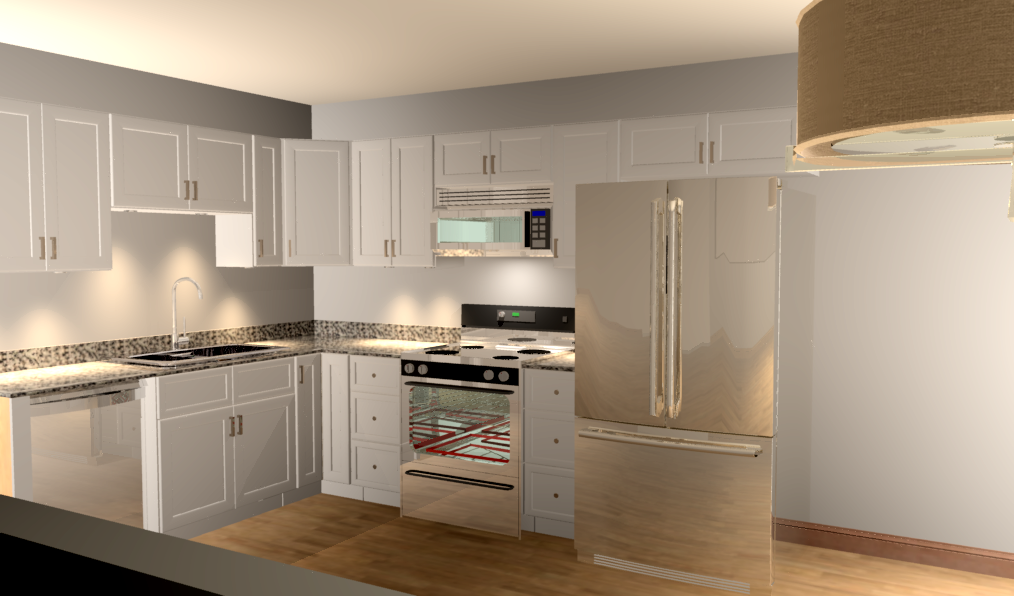Is $10,000 Sufficient for a Kitchen Cabinet Remodel?
Is $10,000 enough for a kitchen cabinet remodel? Absolutely! Smaller kitchens can see remodels ranging from $5,634 to $12,000. However, it's crucial to grasp the variables influencing a remodel's budgetary confines.
There's much to consider: What's the size of your kitchen? Are you swapping out all the cabinets or just the doors? What finish fits your vision? And how much DIY involvement are you comfortable with? These pivotal factors encompass quality, kitchen dimensions, project scale, labor expenses, finish selections, and material choices. Each element plays a critical role in determining the feasibility of keeping a kitchen remodel under the $10,000 threshold.
What Does a Kitchen Cabinet Remodel Include?
Let's start by breaking down what's involved in a kitchen remodel. Apart from expenses like flooring, appliances, and countertops, cabinetry stands out as one of the priciest aspects. That's why it's crucial to budget wisely for it.
Various Types of Cabinet Remodels:
When budgeting for a cabinet remodel, it's essential to understand the various options available and what each entails. Here's a breakdown:
1. Refacing
This involves replacing the cabinet doors and drawer fronts while keeping the existing cabinet boxes intact. It's a cost-effective option that can give your kitchen a fresh look without the expense of entirely new cabinets. Refacing may also include updating the cabinet hardware and applying a new veneer or laminate to the cabinet boxes to match the new doors. This is a great and transformative way to keep a kitchen remodel under $10,000. If your cabinet boxes are in good condition, get a quote for refacing your cabinet doors.
How Much You Can Save By Refacing Your Kitchen Cabinets
An average analysis of costs based on standard sizes.
| Cabinet Door Refacing | Replacing Kitchen Cabinets | |
| Cabinets Doors: | ~$50 per door | ~$50 per door |
| Drawer Fronts: | ~$30 per front | ~$30 per front |
| Soft Close Hinges: | $8 each | $8 each |
| Soft Close Drawer Slides: | ~$25 | ~$25 |
| Labor: | ~$150 per door |
Drawer Box: $40 each
Cabinet Box: $200 per linear foot Demolition and Clean up: $300-500 Labor for Installation: $350 per linear foot |
| Total Costs: | ~$220 per door with Labor | ~$500-650 per cabinet box with Labor |
2. Gut Construction
This is a more extensive remodel that involves completely removing the existing cabinets including cabinet boxes and cabinet doors and replacing them with brand new ones. Gut construction allows for more flexibility in terms of layout, design, and customization. It also provides the opportunity to upgrade other elements of the kitchen, such as countertops, backsplashes, and flooring. While a gut construction may be more difficult to keep under a $10,000 threshold, it is doable based on the size, material, and finish you choose for your kitchen cabinets.
3. Painting/Staining
If your cabinets are in good condition structurally and you are content with your existing door style but just need a cosmetic update, painting or staining them is a budget-friendly option. This involves sanding down the existing finish, applying primer, and then painting or staining the cabinets in the desired color. It can give your kitchen a whole new look without the expense of replacing the cabinets.
4. Hardware Replacement
Sometimes, simply updating the cabinet hardware can make a significant difference in the appearance of your cabinets. This includes replacing knobs, handles, hinges, and other hardware with new ones that better suit your style and preferences.
5. Customization/Additions
Depending on your needs and budget, you may also consider customizing or adding features to your cabinets. This could include installing custom cabinet boxes, pull-out shelves, lazy Susans, or built-in organizers to improve functionality and storage space.
Kitchen Remodel Under $10,000 Case Studies
To better understand the cost of a kitchen cabinet replacement, view these case studies for kitchens under $10,000. These case studies have been designed and quoted by CabinetNow’s professional designers for 10x10 kitchens. The below examples represent the complete replacement of all cabinets. If you choose to reface on your cabinet doors only, it will be 30%-50% less of these costs.
Unfinished Shaker Wood 10x10 Kitchen Cost
Presenting an example of pricing for a 10x10 unfinished Shaker kitchen:
- Unfinished Shaker cabinet doors (MDF panel/paintable hardwood frame)
- Unfinished Solid Shaker drawer fronts (paintable hardwood)
- U-shaped kitchen design
- Unfinished paint grade - Soft Maple cabinet boxes
- Partial Overlay of ½”
- Dovetail-finger jointed Birch drawer boxes
Total Cost: $9,228.72 (including shipping)
Thermofoil/Laminate 10x10 Kitchen Cost
Presenting an example of pricing for a 10x10 thermofoil/laminate kitchen:
- Arlington Thermofoil Doors - 949W White
- Arlington Solid Drawer Fronts - 949W White
- L-Shaped kitchen design
- Melamine Frameless cabinet boxes - White with White Edge Band
- Dovetail - Finger Jointed Birch Drawer Boxes
- Blum Tandem Undermount Soft Close Drawer Slides w/ Locking Mechanism
Total Cost: $8,279.84 (including shipping)
Essential Builder Series 10x10 Kitchen
- Cabinet Exterior Finish: Bright White
- Cabinet Interior Finish: Natural melamine
- Partial overlay doors
- U-shaped kitchen design
- Soft-close hinges
- Drawer Box: 5/8″ Solid wood, Dovetailed
- Drawer Slides: DTC Under mount, Non-soft close
- Cabinet Box: 1/2″, Particleboard, Plywood back
- Cabinet Door Material: MDF door & drawers, rubber wood face frame
- Shelves: Adjustable, 3/4″ Particleboard
- Colors include: Essential White and Essential Gray
- Extensive selection of SKUs, moldings, and modifications
Total Cost: $5,634 (shipping not included)
Premier Shaker Designer White 5PC 10x10 Kitchen
- Cabinet Exterior Finish: Shaker White
- Premium Sherwin-Williams® finish
- U-shaped kitchen design
- Full overlay doors provide a seamless aesthetic
- Soft-close doors and drawers
- Crafted with dovetail construction
- Full extension drawers guarantee easy access
- Durable solid wood cabinet box and drawers
- Colors include: Shaker Sand, Shaker White, Shaker Kodiak, Shaker Espresso
- Full line of accessories and upgrades available.
Total Cost: $8,586 (shipping not included)
Factors to Consider for a $10,000 Kitchen Cabinet Remodel
A $10,000 kitchen remodel has many important factors to consider that play a pivotal role in determining the budget for your cabinets and ultimately keeping a kitchen remodel budget under $10,000 if that’s your goal.
Kitchen Size
The size of your kitchen is a big factor in determining how much your remodel will cost. Smaller kitchens generally cost less to renovate because they require fewer materials and less labor. On the other hand, larger kitchens present both opportunities and challenges, requiring careful planning to stay within budget while achieving your desired outcome.
Learn how to measure your kitchen and get a Free Quote and Design Consultation.
In assessing your kitchen's size, consider not only its physical dimensions but also its layout and configuration. Is it an open-concept space or a compact galley kitchen? Understanding the spatial dynamics will inform critical decisions regarding cabinetry placement, workflow optimization, and aesthetic cohesion.
Project Scope
Are you at a crossroads, contemplating between a full kitchen remodel or simply refreshing the appearance of your space by refacing your existing cabinet doors? Deciding what you want to achieve with your kitchen remodel is perhaps the most critical step in the entire process. It's fundamental to setting the coordinates for your journey before embarking on a kitchen remodel—it provides direction, clarity, and purpose. Here's why clearly defining your goals is so crucial:
1. Avoiding Aimless Spending:
When it comes to cabinetry, having a clear vision helps you avoid aimless spending on unnecessary upgrades or features. Are you looking to simply refresh the appearance of your cabinets with a fresh coat of paint or new hardware, or do you envision a complete transformation with custom cabinets and innovative storage solutions? By clarifying your goals, you can focus your resources on the aspects of cabinetry that will have the most significant impact on your kitchen's functionality and aesthetics, while staying within your budget.
2. Prioritizing Cabinetry Tasks:
Cabinetry encompasses a wide range of tasks, from refacing and repainting to complete replacement and customization. By setting clear goals upfront, you can prioritize these tasks based on their importance to your overall vision and survive a kitchen remodel to avoid costly mistakes and headaches throughout the journey. For example, if maximizing storage space is a top priority, you may choose to invest in custom cabinetry with built-in organizers and pull-out shelves. On the other hand, if you're primarily concerned with updating the look of your kitchen, refacing or repainting your existing cabinets may suffice. After choosing which path to take, you can begin to create a checklist to stay organized and within budget.
3. Managing Expectations for Cabinetry:
Defining your goals helps manage expectations for your cabinetry renovation, both for yourself and any professionals involved in the project. This roadmap will offer you clear guidance for implementing the specific changes you envision for your kitchen. Whether you're aiming to swap out outdated cabinets for sleek modern ones or seeking a simple refresh by updating hardware for a renewed appearance, the options are outlined. Additionally, innovative ideas like replacing upper cabinets with floating shelves for enhanced storage are presented as viable alternatives. This clarity ensures that everyone is on the same page and working towards a common vision, reducing the likelihood of misunderstandings and ensuring a smoother, more successful renovation process.
4. Tailoring the Scope of Cabinetry Work:
With clear goals in mind, you can tailor the scope of cabinetry work to fit your budget and timeline. This may involve making decisions about selecting materials, finishes, and hardware that align with your vision. By focusing your efforts on the aspects of cabinetry that are most important to you, you can achieve a transformation that meets your needs and enhances the overall look and functionality of your kitchen.
5. Maximizing Value in Cabinetry:
Ultimately, defining your goals enables you to maximize the value of your investment in cabinetry. Whether you're looking to increase storage space, improve organization, or enhance the visual appeal of your kitchen, clear goals help you make informed decisions that contribute to your overall vision. By prioritizing the aspects of cabinetry that matter most to you, you can create a space that not only meets your needs but also adds value and increases ROI for your home.
Labor Costs
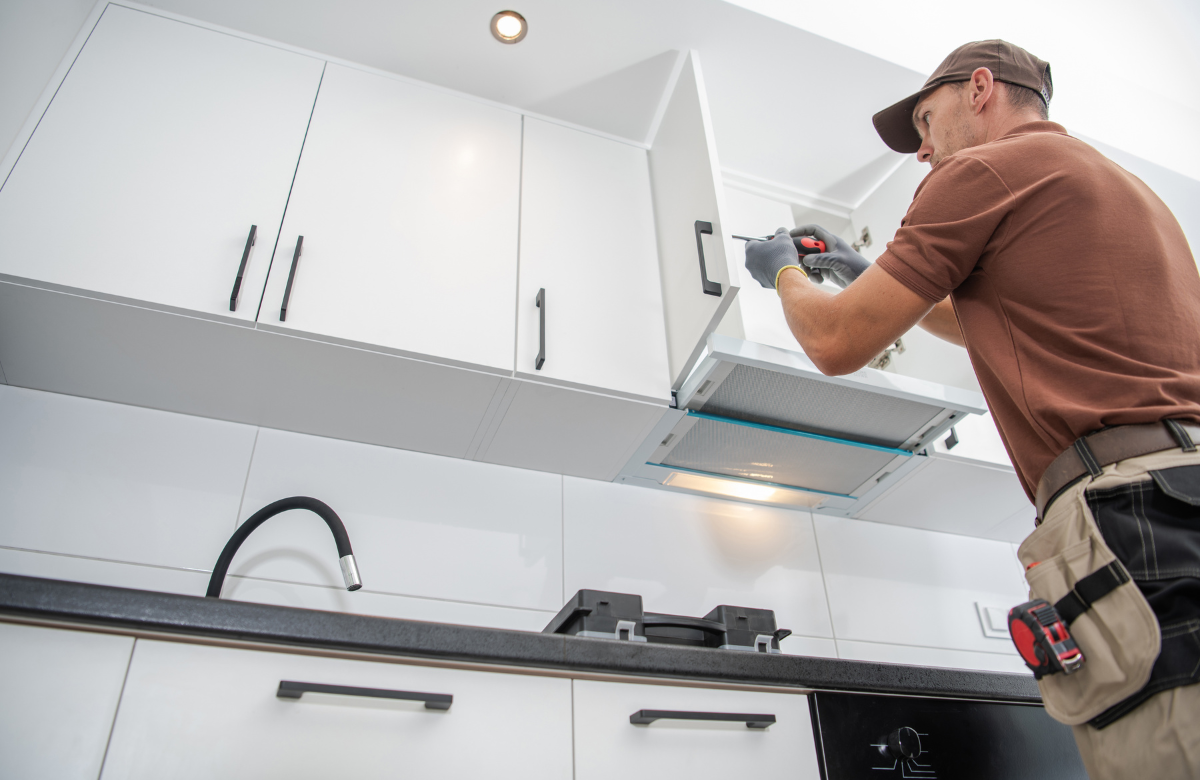
Labor is a significant part of any renovation budget, often comprising a substantial portion of overall expenses. When it comes to tackling a kitchen remodel, homeowners are faced with the decision of whether to embark on a do-it-yourself (DIY) endeavor or enlist the expertise of professionals. Let's break down the considerations and typical costs associated with each option:
DIY Approach
Undertaking a DIY kitchen remodel can be appealing for those who are handy with tools and enjoy taking on home improvement projects. By rolling up your sleeves and diving into the renovation process yourself, you can potentially save money on labor costs. However, it's essential to consider the following factors:
- Skill Level: Assess your proficiency in carpentry, cabinetry installation, plumbing, electrical work, and other relevant tasks. While certain aspects of the remodel may be well within your capabilities, more complex tasks may require specialized knowledge and experience.
- Time Commitment: Renovating a kitchen is a time-consuming endeavor, requiring careful planning, preparation, and execution. Consider whether you have the time and flexibility to dedicate to the project, as well as the patience to navigate any unforeseen challenges along the way.
- Cost of Materials: While DIY labor may be free, the cost of materials can still add up significantly. Be sure to factor in expenses such as cabinets, countertops, flooring, appliances, and fixtures when budgeting for your project.
With CabinetNow, we often help homeowners DIY their projects as best we can with our resources. Whether you choose to reface your cabinet doors and drawers or assemble our RTA (ready to assemble) cabinets for a full kitchen remodel, we've got you covered and are always here for any questions. Contact us at info@cabinetnow.com or work with a designer by filling out our free quote and design consult form.
Being able to assemble your cabinets without having to hire help means you can likely save money. Check out these tables that can show you how much you can save by choosing our cabinet boxes:
Kitchen Remodel Breakdown of Labor Savings
| Avg CabinetNow Cost | Avg Labor Cost Per Hour | Avg Time it Takes to Install | Avg DIYer Savings | |
|
Small Kitchen
7x10 |
$3,400 | $70-$200 | 8-10 hrs | $560-$2,000 |
| Standard 10x10 Kitchen |
$12,400 |
$70-$200 | 16-20hrs |
$1,120-$4,000 |
|
Large Kitchen
20x20 |
$21,800 | $70-$200 | 20-24hrs |
$1,400-$4,800 |
Cabinet Box Only Breakdown of Labor Savings
|
Your Method
(41 ½ Hours)** |
With Cabinetnow.com cabinet boxes
(10 Hours***) |
|
| Cabinet Labor Cost* | $2,510.75 |
$550.00 |
| Cabinet Material Cost | $919.77 | $2,140.63 |
| Total Cost | $3,430.52 | $2,690.63 |
| Money Back in Your Pocket: $739.89 | ||
| Hours of Opportunity Gained 31 ½ Hours | ||
| * Base Figure of 55/ HR | ||
| **Includes Tape off for Finishing | ||
| *** Ability To Flat Finish | ||
| ****Does not include shipping | ||
Labor Saving Benefits
Installing cabinets can be costly and time-consuming going the traditional route. With CabinetNow, we have changed the game by providing cost-effective and time-efficient ways to install cabinets on your own or with the help of a couple of pals.
Listed below are some labor-saving benefits for our RTA custom cabinets.
- Saving money: By ordering our RTA cabinets, you can save money by not having to pay for cabinet installers by the hour which usually ranges from around $55-$200.
- Saving time: You can save hours of researching installers, having them come out to measure, drawing up designs, and the actual installation process which is typically 2-3 days depending on the size of your cabinetry project.
We have designers who help with measurements and draw-up designs with a turnaround time of 1-2 days. You can save up to 31.5 hours with assembly and installation by following our assembly instructions and YouTube videos.
DIY Cabinet Assembly and Installation Resources
- Cabinet Box Assembly Videos
- How to Reface Cabinet Doors
- How to Replace a Drawer Front
- How to Install a Drawer Box
Hiring a Professional
Enlisting the services of skilled tradespeople can offer several advantages, including expertise, efficiency, and peace of mind. While hiring professionals typically involves higher upfront costs, the quality of workmanship and the convenience of having the project handled by experienced professionals can be well worth the investment. Here are some typical costs associated with hiring professionals for a kitchen remodel:
- Cabinet Installation: Professional cabinet installation can cost anywhere from $2,000 to $8,000 or more, depending on factors such as the size of the kitchen, the complexity of the installation, and the materials used.
- Countertop Fabrication and Installation: The cost of countertop fabrication and installation varies depending on the material chosen (e.g., granite, quartz, laminate) and the size of the kitchen. Expect to pay between $1,500 and $5,000 or more for countertop installation.
- Plumbing and Electrical Work: Hiring licensed plumbers and electricians to handle plumbing and electrical work can cost several hundred to several thousand dollars, depending on the scope of the project and local labor rates.
- Overall Labor Costs: In addition to specific tasks like cabinet installation and countertop fabrication, homeowners should budget for overall labor costs, which can vary widely depending on the extent of the remodel and the rates charged by contractors in their area. Overall, labor costs for a kitchen remodel typically range from $5,000 to $20,000 or more, depending on the scope of the project and the level of customization desired.
Ultimately, the decision to DIY or hire professionals depends on factors such as your skill level, time availability, budget, and desired outcome. While DIY projects can be rewarding for those with the necessary skills and resources, hiring professionals ensures a higher level of expertise and craftsmanship, as well as a smoother, more efficient renovation process. We recommend checking out TaskRabbit.com to compare prices and experience for finding the perfect professional in your local area.
Cabinet Door Styles and Customizations
The style of cabinetry you choose not only contributes to the overall look and feel of your kitchen but also influences the cost of your remodel. At CabinetNow, we understand that every detail matters and our customizable options allow you to tailor your cabinetry to suit your unique preferences and budget.
- Customizations: When it comes to cabinetry, even seemingly minor customizations can impact the final cost. For example, boring the door for hinges, which ensures proper installation, may incur an additional fee of $10 per door. Similarly, adding glass panel lites to your door style for a touch of elegance or incorporating rubber stops for quiet closing mechanisms are optional upgrades that come at an extra cost.
- Edge Profiles: The choice to change the outside or inside edge profile of your cabinet doors can also affect pricing. Opting for a more intricate edge profile adds a level of sophistication but may increase the overall cost of your cabinetry per cabinet door.
- Door Styles: The style of cabinet doors is a key factor in determining cost. Simple and streamlined door styles, such as flat-panel or Shaker doors, are typically more budget-friendly compared to more ornate styles like raised panel or cathedral doors. Each door style has its own unique aesthetic appeal and price point, allowing you to find the perfect balance between style and affordability.
- Hardware Selection: The choice of hardware, including knobs, pulls, and hinges, can also impact the overall cost of your cabinetry. High-quality hardware adds a polished finishing touch to your cabinets but may come with a higher price tag. Alternatively, more budget-friendly hardware options are available for those looking to save on costs without compromising on style.
By carefully considering factors such as customizations, edge profiles, door styles, and hardware selection, you can create cabinetry that not only reflects your style but also fits within your budget. At CabinetNow, we offer a wide range of customizable options to help you achieve the kitchen of your dreams without overspending.
Finishes
The finishes you select for your kitchen, from paint colors to cabinet hardware, play a crucial role in defining its aesthetic. It's essential to strike a balance between style and affordability while considering both cost and durability.
Finish Options at CabinetNow:
At CabinetNow, we offer a diverse range of finishes, catering to various preferences and budgets. Options include:
Considerations for Cost and Durability:
Understanding how each finish choice impacts overall costs is vital. For example:
- Unfinished wood serves as a base price, with variations based on wood species. For instance, White Oak Select may cost more than Red Oak.
- Painted wood incurs additional costs of $53.50, for primer ($26.20) and clear coat ($24.60) application, in addition to the base price and any wood species premiums.
- Thermofoil presents a cost-effective alternative, providing durability and a fully finished appearance at a lower price point compared to wood.
Budget-Friendly Recommendations:
For budgets under $10,000 for a kitchen cabinet remodel:
- Consider unfinished wood for its versatility and cost-effectiveness. Finish it yourself or with professional assistance for a customized look.
- Thermofoil offers a fully finished solution at a competitive price, ideal for budget-conscious homeowners seeking style and affordability.
Final Considerations:
While our cabinet boxes come unfinished, the choice of cabinet door finish significantly impacts overall costs. By carefully weighing your options and considering factors such as style, durability, and budget, you can create a beautiful and functional kitchen that meets your needs.
Material
CabinetNow prides itself on offering a diverse array of materials tailored specifically for wood. Your choice of material not only influences the look and feel of your cabinets but also has a direct impact on your budget. Here's a closer look at the options available:
Wood Selection
When it comes to wood selection, the species you choose can significantly affect pricing. While White Oak is known for its durability and elegant grain patterns, it typically commands a higher price point. In contrast, Red Oak offers a more budget-friendly option without compromising on quality. MDF Panel with a Paintable Hardwood Frame is the cheapest wood option you will find.
Alternative Materials
- Thermofoil: Thermofoil presents a modern and cost-effective alternative to traditional wood. This vinyl laminate is heated and pressurized onto an MDF core, resulting in a seamless and durable finish. Thermofoil cabinets offer a sleek aesthetic and easy maintenance, making them an attractive choice for budget-conscious homeowners.
- MDF (Medium Density Fiberboard): As the most budget-friendly option, MDF provides a versatile and economical solution for cabinet construction. Composed of wood fibers and resin, MDF offers a smooth and uniform surface ideal for painting or laminating. While MDF may lack the natural charm of wood, its affordability makes it a popular choice for budget-conscious projects.
Considerations for Material Selection
When selecting a material for your cabinets, it's essential to find the right balance between quality and affordability. While premium materials may entail a higher initial investment, their durability, and visual appeal often justify the expense over time. Conversely, opting for more budget-friendly options like Thermofoil or MDF can help keep costs in check without sacrificing style or functionality.
Material selection plays a pivotal role in determining the longevity and visual appeal of your cabinets. By carefully evaluating the pros and cons of each option and considering your budgetary constraints, you can make an informed decision that enhances the beauty and functionality of your kitchen for years to come.
Working with a Designer to Keep Your $10,000 Kitchen Remodel Budget
When working with a designer, you have the advantage of collaborating with skilled professionals who possess the expertise to help bring your vision to life within your budgetary constraints. These designers understand the intricacies of kitchen cabinet remodeling and can offer valuable guidance to ensure that every design choice aligns with your preferences, needs, and budget. Designers also can generate 3D renderings, providing you with a visual representation of how your new kitchen could appear.
Design considerations play a crucial role in determining the overall cost of a kitchen cabinet remodel. By exploring various options such as cabinet layout, door styles, hardware, finishes, and accessories, homeowners can tailor their design to meet both aesthetic preferences and financial limitations.
- Initial Consultation: The first step in collaborating with a designer is to schedule an initial consultation. During this meeting, you can discuss your vision for the project and outline your budget constraints. Providing pictures of your current kitchen space allows the designer to gain a better understanding of the existing layout and potential challenges.
- Define Project Scope: Clearly define the scope of your project with your designer. Whether you're planning a full kitchen remodel or simply refacing your cabinets, it's essential to communicate your goals and expectations. This includes discussing which aspects of the kitchen you wish to update and any specific features or functionalities you desire.
- Set Budget Goals: Establishing clear budget goals is crucial for ensuring that your kitchen remodel stays under the $10,000 limit. Be transparent with your designer about your financial constraints and desired spending limits. Together, you can work to prioritize essential upgrades and allocate funds accordingly.
- Take Measurements: If you're planning a kitchen remodel, taking accurate measurements of your space is essential. This includes measuring the dimensions of the room, as well as the layout and size of existing cabinets, appliances, and countertops. For cabinet refacing projects, measure each cabinet box opening to ensure the precise fitting of new doors and drawer fronts.
- Choose Style, Material, and Finish: Work closely with your designer to select the style, material, and finish that best suits your aesthetic preferences and budget. Consider opting for cost-effective materials like thermofoil or MDF for cabinet refacing projects, or explore alternative finishes that mimic the look of more expensive materials.
- Collaborative Adjustment: Throughout the design process, maintain open communication with your designer to make any necessary adjustments to stay within your budget. Your designer can offer valuable insights and alternative solutions to help achieve your desired look without exceeding your financial limitations. By working together collaboratively, you can ensure that every aspect of your kitchen remodel aligns with your budget goals and vision for the space.
By working closely with a CabinetNow designer and carefully considering design choices, homeowners can create a customized kitchen cabinet remodel that reflects their style preferences and meets their budgetary constraints. With the expertise and guidance of skilled professionals, homeowners can confidently navigate the design process and achieve their dream kitchen within their desired budget. CabinetNow's Free Quote and Design Consult and Free Quote for Refacing Forms walk you through this process before the initial consultation.
Hidden Costs to Watch Out For
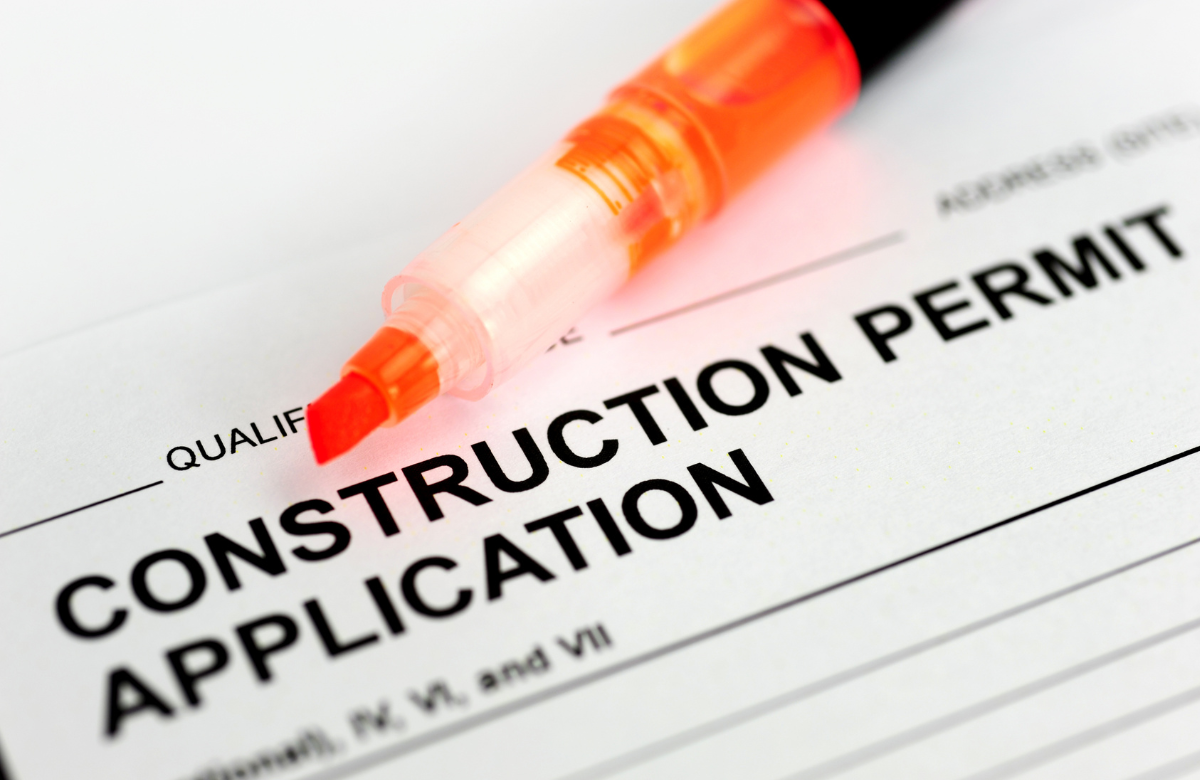
- Permit Fees: Many homeowners overlook the need for permits when undertaking a kitchen cabinet remodel. Depending on local regulations, permits may be required for tasks such as electrical or plumbing work, structural modifications, or major renovations. Obtaining permits incurs additional fees, which should be factored into the overall budget. Go to your local city government site to explore these regulations. For example, Louisvilleky.gov. When working with a licensed contractor for your kitchen remodel, they will have the expertise to determine which permits are necessary for the job.
- Disposal Costs: Disposing of old cabinets and construction debris can incur significant costs. Homeowners may need to rent a dumpster or hire a waste removal service to properly dispose of materials. The size of the project and the amount of debris generated will impact disposal costs, so it's essential to budget accordingly.
- Unexpected Repairs: Once the demolition phase begins, unforeseen issues may arise that require repairs or modifications. This could include hidden water damage, structural deficiencies, or outdated plumbing/electrical systems. Addressing these unexpected repairs can add to the overall cost of the remodel, so it's wise to set aside a contingency fund to cover such expenses.
- Additional Materials or Services: Homeowners may encounter unexpected expenses for additional materials or services not initially accounted for in the budget. This could include specialty hardware, custom trim or molding, or professional design fee consultations. Additionally, changes in design plans or unforeseen complications may necessitate additional materials or services, leading to higher costs than anticipated.
- Shipping Fees: When purchasing cabinets or materials from suppliers, shipping fees may not be initially apparent but can add up significantly. Depending on the size and weight of the items, as well as the distance they need to be shipped, these fees can impact the overall cost of the project. It's important to inquire about shipping fees upfront and include them in the budget to avoid surprises later on. This is why getting a quote is important.
- Timeline Extensions: Delays in the renovation timeline can result in additional costs for homeowners. Extended timelines may require temporary kitchen setups, such as renting portable cooking appliances or eating out more frequently. Additionally, contractors may charge additional fees for overtime or expedited services to meet deadlines, further adding to the overall cost of the project.
- Finishing Touches: Homeowners often overlook the cost of finishing touches that add polish and functionality to their newly renovated kitchen. This could include items such as window treatments, lighting fixtures, backsplash installation, or decorative accents. While these finishing touches may seem minor, their cumulative cost can add up quickly and should be factored into the budget from the outset.
How to Achieve a $10,000 Kitchen Remodel
In summary, achieving a successful kitchen cabinet remodel under a $10,000 budget requires careful planning and consideration of various factors. By understanding the breakdown of costs and anticipating potential hidden expenses such as disposal fees, permits, and unexpected repairs, homeowners can set realistic budget expectations. Factors affecting costs, including kitchen size, cabinet materials, and design complexity, should be carefully weighed when making decisions. Choosing cost-effective materials like unfinished wood or thermofoil, prioritizing essential upgrades, and considering DIY options for tasks such as painting or refacing can help minimize expenses. Additionally, homeowners should shop around for discounts and sales on materials and fixtures to further stretch their budget. By implementing these cost-saving strategies and remaining mindful of potential expenses, homeowners can effectively manage their budget and achieve a successful kitchen cabinet remodel while keeping their kitchen remodel under a $10,000 budget.
| Summary | |
| Aspect | Information |
| Budget Breakdown | - Understand the breakdown of costs, including materials, labor, finishes, and permits. - Anticipate potential hidden costs such as disposal fees, unexpected repairs, and permits. |
| Factors Affecting Costs | - Kitchen size, cabinet materials, design complexity, and labor rates influence costs. |
| Material Options | - Choose cost-effective materials like unfinished wood, thermofoil, or MDF. |
| Design Considerations | - Prioritize essential upgrades and opt for simpler designs to save on costs. |
| DIY vs. Professional | - Consider DIY options for tasks like painting or refacing to save on labor costs. - Hire professionals for complex tasks or when quality is paramount. |
| Cost-Saving Strategies | - Reface existing cabinets instead of replacing them entirely. - Choose budget-friendly materials like thermofoil or MDF. - Opt for DIY installation or painting to save on labor costs. - Prioritize essential upgrades and postpone non-essential features. - Shop around for discounts, sales, or clearance deals on materials and fixtures. |
 MADE IN THE USA
MADE IN THE USA


